Our Lady of Fatima Roman Catholic Church

Our Lady of Fatima Roman Catholic Church is a Roman Catholic church located in the East Elmhurst neighborhood of Queens, New York City. The church property occupies a city block bounded by 80th Street, 79th Street, 30th Avenue, and 25th Avenue, and is adjacent to the LaGuardia Landing Lights Fields. Half of the property is used by Our Lady of Fatima School, a Catholic school for nursery to 8th Grade. The main entrance of the Church is located along 80th Street. The MTA Q47 bus service to Marine Air Terminal at LaGuardia Airport and The Shops at Atlas Park in Glendale passes by Our Lady of Fatima Church. Our Lady of Fatima Church also has a convent and a rectory.
Excerpt from the Wikipedia article Our Lady of Fatima Roman Catholic Church (License: CC BY-SA 3.0, Authors, Images).Our Lady of Fatima Roman Catholic Church
80th Street, New York Queens
Geographical coordinates (GPS) Address Website Nearby Places Show on map
Geographical coordinates (GPS)
| Latitude | Longitude |
|---|---|
| N 40.762308333333 ° | E -73.888944444444 ° |
Address
Our Lady of Fatima Church
80th Street 25-14
11370 New York, Queens
New York, United States
Open on Google Maps








